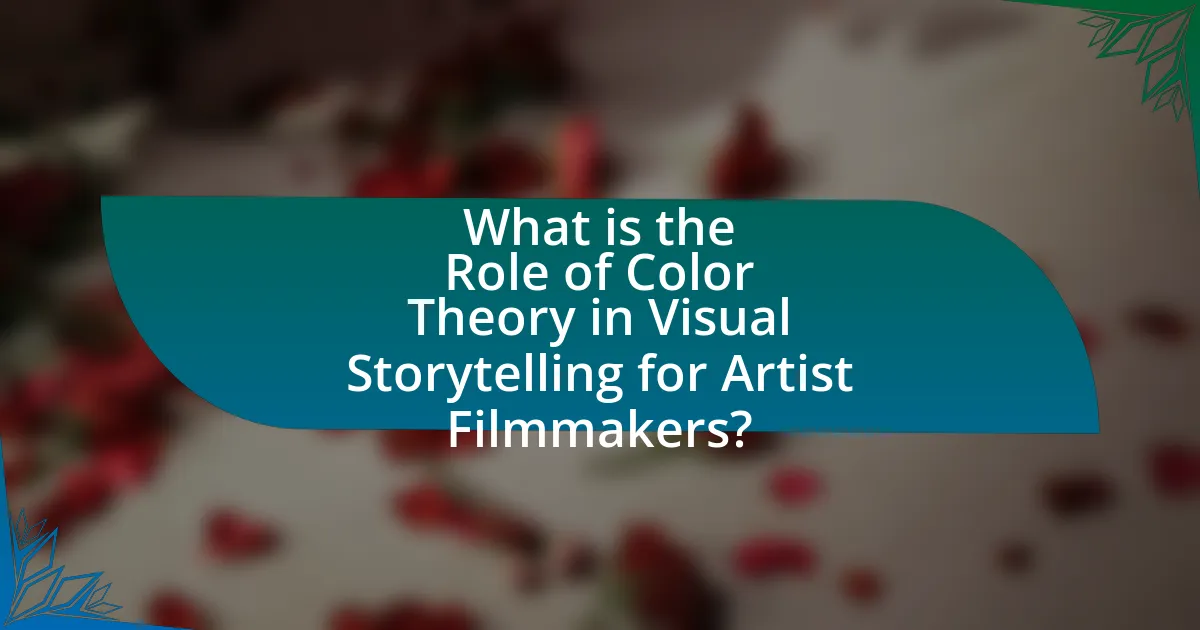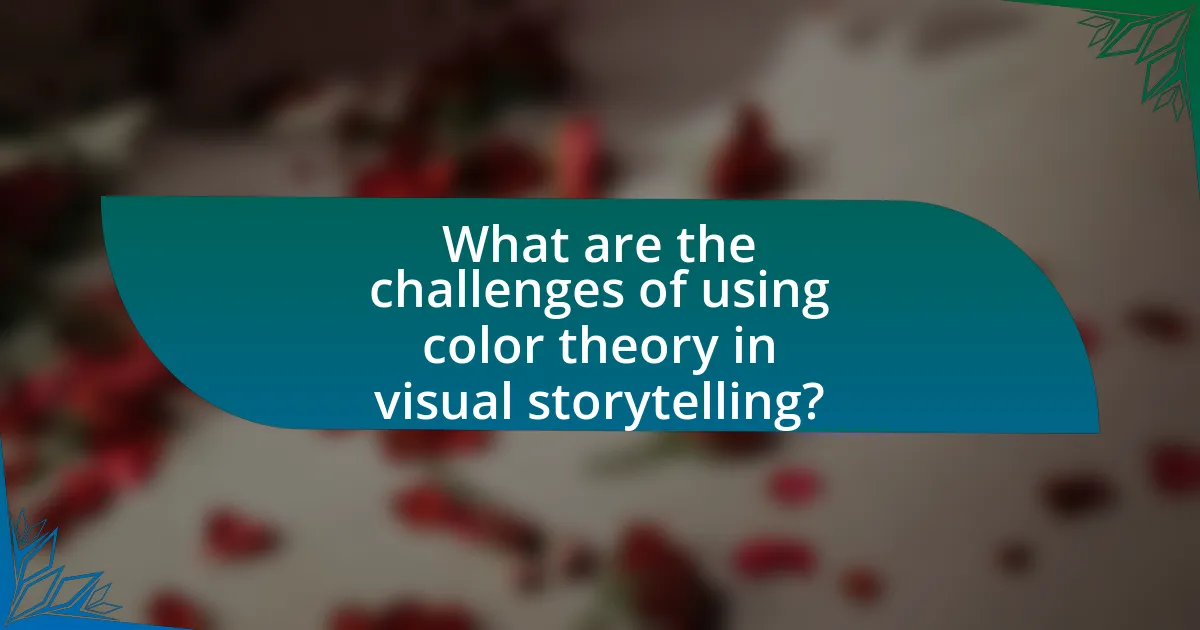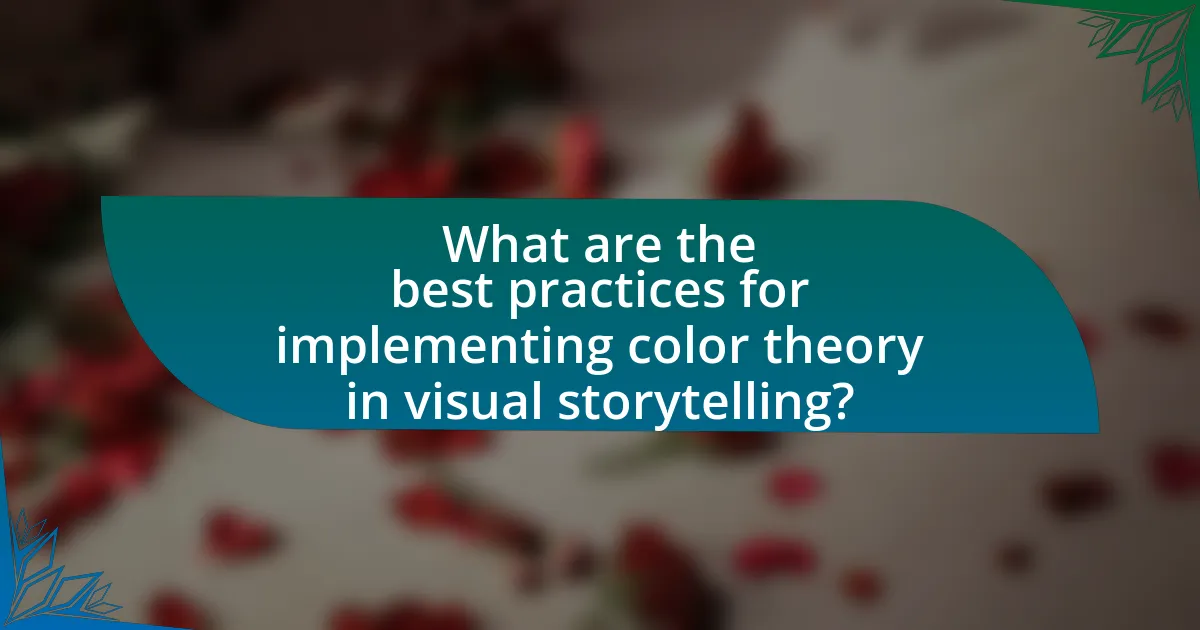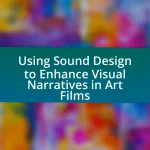The article examines the critical role of color theory in visual storytelling for artist filmmakers, highlighting how color influences emotional tone, narrative depth, and audience perception. It discusses the fundamental principles of color theory, including color harmony and psychological effects, and explores various color schemes used in filmmaking, such as monochromatic and complementary schemes. Additionally, the article addresses the impact of color on character development, mood, and the challenges filmmakers face in color application, including cultural sensitivities and common pitfalls. Practical tips for mastering color theory and enhancing storytelling through effective color strategies are also provided.

What is the Role of Color Theory in Visual Storytelling for Artist Filmmakers?
Color theory plays a crucial role in visual storytelling for artist filmmakers by influencing the emotional tone and narrative depth of their work. By utilizing color palettes, filmmakers can evoke specific feelings, guide audience perception, and enhance character development. For instance, warm colors like red and orange can create a sense of urgency or passion, while cool colors such as blue and green can evoke calmness or sadness. Research indicates that color can affect viewer emotions and interpretations, as demonstrated in studies like those by Elliot and Maier (2014), which show that color influences mood and behavior. Thus, artist filmmakers strategically apply color theory to craft compelling visual narratives that resonate with audiences on an emotional level.
How does color theory influence visual storytelling?
Color theory significantly influences visual storytelling by guiding the emotional and psychological responses of the audience through color choices. For instance, warm colors like red and orange can evoke feelings of passion or urgency, while cool colors such as blue and green often convey calmness or sadness. This application of color can enhance narrative elements, as seen in films like “The Grand Budapest Hotel,” where a specific color palette reinforces the whimsical yet melancholic tone of the story. Research indicates that color can affect mood and perception, with studies showing that colors can influence viewer emotions and interpretations of scenes, thereby shaping the overall storytelling experience.
What are the fundamental principles of color theory?
The fundamental principles of color theory include the color wheel, color harmony, and the psychological effects of color. The color wheel, developed by Isaac Newton, organizes colors into a circular format, illustrating primary, secondary, and tertiary colors. Color harmony refers to the aesthetically pleasing combinations of colors, which can be achieved through various schemes such as complementary, analogous, and triadic. The psychological effects of color highlight how different colors can evoke specific emotions and responses in viewers, influencing their perception and interpretation of visual narratives. These principles are essential for artist filmmakers as they guide the use of color to enhance storytelling and emotional impact in their work.
How do color harmonies affect audience perception?
Color harmonies significantly influence audience perception by evoking specific emotional responses and guiding viewer attention. For instance, complementary color schemes create contrast that can heighten visual interest and draw focus to key elements, while analogous colors promote harmony and tranquility, fostering a sense of cohesion in the narrative. Research by the Institute for Color Research indicates that people make a subconscious judgment about a person, environment, or product within 90 seconds of initial viewing, with color being a primary factor in that assessment. This demonstrates that effective use of color harmonies can enhance storytelling by aligning visual elements with the intended emotional tone, ultimately shaping how audiences interpret and engage with the visual narrative.
Why is color important in the context of filmmaking?
Color is important in filmmaking because it influences audience emotions and perceptions, enhancing storytelling. For instance, warm colors like red and orange evoke feelings of warmth and passion, while cool colors like blue and green can create a sense of calm or sadness. Research indicates that color can significantly affect mood and psychological responses; a study published in the Journal of Experimental Psychology found that color can alter viewers’ emotional reactions to visual stimuli. Thus, filmmakers strategically use color to convey themes, establish mood, and guide audience reactions, making it a crucial element in visual storytelling.
How does color contribute to mood and emotion in film?
Color significantly contributes to mood and emotion in film by influencing viewers’ psychological responses. For instance, warm colors like red and orange can evoke feelings of passion or anger, while cool colors such as blue and green often create a sense of calm or sadness. Research indicates that color can affect emotional perception; a study published in the journal “Color Research and Application” by researchers from the University of California found that specific colors can elicit distinct emotional reactions, reinforcing the idea that filmmakers strategically use color palettes to enhance storytelling. This intentional use of color not only shapes the audience’s emotional experience but also guides their interpretation of characters and narrative arcs.
What role does color play in character development and narrative?
Color plays a significant role in character development and narrative by influencing audience perception and emotional response. In visual storytelling, specific colors can symbolize traits or emotions associated with characters, such as red representing passion or danger, while blue may convey calmness or sadness. For instance, in films like “The Sixth Sense,” the use of color grading highlights the emotional states of characters, enhancing the narrative’s psychological depth. Research indicates that color can evoke specific feelings and associations, impacting how viewers interpret character motivations and relationships, thereby shaping the overall narrative experience.
What are the different color schemes used by artist filmmakers?
Artist filmmakers utilize various color schemes to enhance visual storytelling, including monochromatic, analogous, complementary, triadic, and split-complementary schemes. Monochromatic schemes use variations of a single color to create harmony and mood, as seen in films like “The Great Gatsby,” where green hues symbolize wealth and envy. Analogous color schemes, which involve colors next to each other on the color wheel, create a serene and cohesive look, exemplified in “Moonlight,” where blues and greens evoke emotional depth. Complementary schemes, featuring opposite colors, generate contrast and vibrancy, effectively used in “The Grand Budapest Hotel” to highlight whimsical elements. Triadic schemes, which use three evenly spaced colors, provide balance and dynamism, as demonstrated in “Mad Max: Fury Road,” where bold colors enhance the film’s energy. Lastly, split-complementary schemes offer a variation of complementary colors, allowing for visual interest without overwhelming contrast, often seen in character-driven narratives. These color schemes are integral to conveying themes, emotions, and character dynamics in artist filmmakers’ works.
How do complementary colors enhance visual storytelling?
Complementary colors enhance visual storytelling by creating contrast that draws attention and evokes emotional responses. When used strategically, these colors can highlight key elements in a scene, guiding the viewer’s focus and enhancing narrative depth. For instance, in film, the use of complementary colors can signify conflict or harmony, as seen in the contrasting use of blue and orange in many cinematic works, which not only creates visual interest but also reinforces thematic elements. This technique is supported by color theory, which indicates that complementary colors, positioned opposite each other on the color wheel, intensify each other’s impact, making scenes more dynamic and engaging for the audience.
What is the impact of monochromatic color schemes in film?
Monochromatic color schemes in film create a unified visual aesthetic that enhances emotional resonance and thematic depth. By utilizing variations of a single color, filmmakers can evoke specific moods and feelings, guiding audience perception and interpretation. For instance, films like “The Road” employ a desaturated palette to convey bleakness and despair, while “The Grand Budapest Hotel” uses vibrant monochromatic schemes to evoke nostalgia and whimsy. This strategic use of color not only reinforces narrative elements but also establishes a distinct visual identity, making the film more memorable and impactful.
How can artist filmmakers effectively apply color theory in their work?
Artist filmmakers can effectively apply color theory by utilizing color palettes that evoke specific emotions and enhance narrative elements. By understanding the psychological impact of colors, such as blue for calmness or red for intensity, filmmakers can create visual storytelling that resonates with audiences. Research indicates that color can influence viewer perception and emotional response, as demonstrated in studies like those by Elliot and Maier (2014), which show that color affects mood and behavior. Additionally, employing color contrast and harmony can guide viewer attention and emphasize key themes, making the visual experience more engaging and meaningful.
What techniques can be used to create a cohesive color palette?
To create a cohesive color palette, artists can utilize techniques such as color harmony, the color wheel, and limiting the color palette. Color harmony involves selecting colors that complement each other, such as analogous colors (colors next to each other on the color wheel) or complementary colors (colors opposite each other). The color wheel serves as a guide to understand relationships between colors, helping artists choose combinations that evoke specific emotions or themes. Limiting the color palette to a few key colors can enhance unity and focus within a visual narrative, as seen in films like “Moonlight,” where a restricted palette reinforces the emotional tone. These techniques are grounded in color theory, which emphasizes the psychological impact of color combinations on storytelling.
How can color grading enhance the storytelling process?
Color grading enhances the storytelling process by establishing mood, emphasizing themes, and guiding audience emotions. Through the manipulation of color tones, filmmakers can evoke specific feelings; for instance, warm colors can create a sense of comfort or nostalgia, while cool colors may evoke sadness or tension. Research indicates that color can significantly influence viewer perception and emotional response, as demonstrated in studies like “The Impact of Color on Marketing” by Satyendra Singh, which highlights how color affects consumer behavior and emotional engagement. Thus, effective color grading not only supports narrative elements but also deepens the audience’s connection to the story being told.

What are the challenges of using color theory in visual storytelling?
The challenges of using color theory in visual storytelling include the subjective interpretation of colors, cultural differences in color perception, and the complexity of color combinations. Subjective interpretation means that colors can evoke different emotions and meanings for different viewers, making it difficult for filmmakers to achieve a universally understood message. Cultural differences further complicate this, as colors may carry distinct connotations in various cultures; for example, white symbolizes purity in some cultures but mourning in others. Additionally, the complexity of color combinations can lead to visual clutter or confusion if not executed thoughtfully, as seen in studies showing that harmonious color palettes enhance viewer engagement while discordant colors can detract from the narrative.
What common pitfalls do filmmakers encounter with color choices?
Filmmakers commonly encounter pitfalls such as poor color harmony, over-saturation, and neglecting cultural color meanings when making color choices. Poor color harmony can lead to visual dissonance, making scenes feel chaotic or unappealing; for instance, using clashing colors can distract viewers from the narrative. Over-saturation often results in unrealistic visuals that can detract from the story’s emotional impact, as seen in films where colors overwhelm the intended mood. Additionally, neglecting cultural color meanings can lead to misinterpretations; for example, red symbolizes danger in some cultures but love in others, which can confuse audiences if not considered. These pitfalls highlight the importance of understanding color theory in visual storytelling.
How can over-saturation affect audience engagement?
Over-saturation can negatively impact audience engagement by overwhelming viewers with excessive visual stimuli, leading to desensitization. When colors are overly vibrant or intense, they can distract from the narrative and emotional depth of the story, causing audiences to disengage. Research indicates that high levels of color saturation can lead to cognitive overload, making it difficult for viewers to process information effectively. For instance, a study published in the Journal of Consumer Research found that overly saturated colors can diminish emotional responses and reduce the likelihood of retaining information, ultimately resulting in lower engagement levels.
What are the risks of inconsistent color usage throughout a film?
Inconsistent color usage throughout a film can lead to viewer confusion and disengagement. When colors do not align with the narrative or emotional tone, audiences may struggle to understand character motivations or thematic elements, resulting in a disjointed viewing experience. Research indicates that color consistency enhances emotional resonance; for instance, a study published in the Journal of Visual Communication found that films with cohesive color palettes are perceived as more professional and emotionally impactful. Therefore, inconsistent color application risks undermining the film’s overall effectiveness and audience connection.
How can cultural differences influence color perception in film?
Cultural differences significantly influence color perception in film by shaping the emotional and symbolic meanings associated with colors. For instance, in Western cultures, white is often associated with purity and weddings, while in many Eastern cultures, it symbolizes mourning and funerals. This divergence in color symbolism can affect how audiences interpret scenes and characters in films. Research by Paul Ekman on cultural emotions indicates that color perception is not universal; rather, it is deeply rooted in cultural contexts, which filmmakers must consider to effectively communicate their narratives.
What are some examples of color symbolism across different cultures?
Color symbolism varies significantly across cultures, with specific colors representing distinct meanings. In Western cultures, white symbolizes purity and innocence, often associated with weddings. In contrast, in many Eastern cultures, particularly in China, white is linked to mourning and death. Red holds a powerful significance in Chinese culture, symbolizing good fortune and joy, while in South Africa, it can represent mourning. Blue is often seen as a symbol of tranquility and peace in Western contexts, but in some Middle Eastern cultures, it can signify protection against evil. Green is associated with fertility and nature in many cultures, including Islam, where it represents paradise. These examples illustrate how color meanings can differ widely, reflecting cultural values and beliefs.
How can filmmakers navigate cultural sensitivities related to color?
Filmmakers can navigate cultural sensitivities related to color by conducting thorough research on the cultural meanings and associations of colors in different societies. Understanding that colors can evoke various emotions and symbolize distinct concepts across cultures is crucial; for instance, while white signifies purity in Western cultures, it may represent mourning in some Eastern cultures. Engaging with cultural consultants or collaborating with local artists can provide valuable insights and ensure respectful representation. Additionally, filmmakers should consider audience feedback during the development process to identify potential misinterpretations or offensive uses of color. This approach not only enhances cultural sensitivity but also enriches the storytelling experience by fostering inclusivity and understanding.

What are the best practices for implementing color theory in visual storytelling?
The best practices for implementing color theory in visual storytelling include understanding the emotional impact of colors, using color palettes consistently, and leveraging color contrast to enhance visual narratives. Emotional responses to colors are well-documented; for instance, red often evokes passion or urgency, while blue can convey calmness or sadness. Consistent color palettes help establish a cohesive visual identity, as seen in films like “The Grand Budapest Hotel,” where a specific color scheme reinforces the film’s whimsical tone. Additionally, utilizing color contrast can draw attention to key elements in a scene, guiding the viewer’s focus and enhancing storytelling, as demonstrated in the works of filmmakers like Wes Anderson and Guillermo del Toro.
How can filmmakers create a color strategy for their projects?
Filmmakers can create a color strategy for their projects by defining the emotional tone and narrative themes they wish to convey through color choices. This involves selecting a color palette that aligns with the story’s mood, character development, and visual aesthetics. For instance, a study by the American Psychological Association indicates that colors can evoke specific emotions; blue often conveys calmness, while red can signify passion or danger. By understanding these associations, filmmakers can strategically use color to enhance storytelling, guide audience perception, and create a cohesive visual experience.
What tools and resources are available for color analysis?
Color analysis tools and resources include software applications, color wheels, and online platforms. Software like Adobe Color and Coolors allows users to create and analyze color palettes, while color wheels help visualize color relationships and harmonies. Online resources such as color theory websites and educational platforms provide tutorials and guides on color usage in visual storytelling. These tools are essential for artist filmmakers to effectively apply color theory in their work, enhancing narrative and emotional impact.
How can collaboration with colorists enhance the final product?
Collaboration with colorists enhances the final product by ensuring that the visual narrative aligns with the intended emotional tone and aesthetic vision of the project. Colorists possess specialized skills in color grading, which can significantly elevate the visual quality and coherence of a film or artwork. For instance, studies have shown that color grading can influence audience perception and emotional response, with specific color palettes evoking distinct feelings. By working closely with colorists, filmmakers can achieve a polished look that not only enhances storytelling but also engages viewers more effectively, ultimately leading to a more impactful final product.
What practical tips can artist filmmakers use to master color theory?
Artist filmmakers can master color theory by studying the color wheel and understanding color relationships, such as complementary, analogous, and triadic schemes. This foundational knowledge allows filmmakers to create visually appealing compositions that enhance storytelling. For instance, using complementary colors can create contrast and draw attention to key elements, while analogous colors can evoke harmony and emotion. Additionally, practical exercises like color grading in post-production and experimenting with color palettes in different scenes can solidify their understanding. Research indicates that color influences viewer perception and emotional response, making mastery of color theory essential for effective visual storytelling.
How can studying art and design improve a filmmaker’s understanding of color?
Studying art and design enhances a filmmaker’s understanding of color by providing foundational knowledge of color theory, which includes the relationships between colors, color harmony, and the emotional impact of color choices. This knowledge allows filmmakers to make informed decisions about color palettes that can evoke specific moods and convey narrative themes effectively. For instance, the use of complementary colors can create visual tension, while analogous colors can produce harmony, both of which are essential in visual storytelling. Additionally, exposure to various artistic movements and styles informs filmmakers about historical and cultural contexts of color usage, enriching their creative approach.
What exercises can help filmmakers experiment with color in their storytelling?
Filmmakers can experiment with color in their storytelling through exercises such as creating color palettes for specific scenes, conducting color grading tests, and analyzing films with distinct color themes. Creating color palettes involves selecting a range of colors that evoke specific emotions or themes, which helps filmmakers understand the psychological impact of color. Conducting color grading tests allows filmmakers to manipulate colors in post-production, observing how different hues affect the mood and tone of a scene. Analyzing films with distinct color themes, such as “The Grand Budapest Hotel” or “Moonlight,” provides insight into how color choices contribute to narrative and character development, reinforcing the importance of color theory in visual storytelling.

